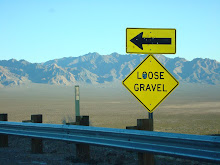I happened to notice a Nevada Historic Marker on the roadside on my way to Beatty, NV. Being that I was the only car from horizon to horizon, stopping and turning back was no problem.
It's kind of a cruel joke to put text on a sign that is small enough to make you get out of the car, only to realize you are standing on the Nevada Nuclear Test Site.


"Jackass Valley". Ha. Haha.

 Troops watch a nuclear field exercise at the Nevada test site in 1951
Troops watch a nuclear field exercise at the Nevada test site in 1951Between 1951 and 1992, there were a total of 928 announced nuclear tests. 828 taking place underground. (seismic data have indicated there may have been many unannounced underground tests as well-Wiki).
From Wikipedia:
During the 1950s, the mushroom cloud from these tests could be seen for almost 100 miles in either direction, including the city of Las Vegas, where the tests became tourist attractions. Americans headed for Las Vegas to witness the distant mushroom clouds that could be seen from the downtown hotels.
On July 17, 1962 the test shot "Little Feller I" of Operation Sunbeam became the last atmospheric test detonation at the Nevada Test Site. Underground testing of weapons continued until September 23, 1992, and although the United States did not ratify the Comprehensive Test Ban Treaty, the articles of the treaty are nevertheless honored and further tests have not occurred. Tests not involving the full creation of a critical mass ("subcritical" testing) continue.
One notable test shot was the "Sedan" shot of Operation Storax, a 104 kiloton shot for the Operation Plowshare which sought to prove that nuclear weapons could be used for peaceful means in creating bays or canals—it created a crater 1,280 feet (390 m) wide and 320 feet (100 m) deep that can still be seen today. While most of the larger tests were conducted elsewhere, NTS was home to tests in the 500 kiloton to 1 megaton (2 to 4 petajoule) range, which caused noticeable seismic effects in Las Vegas.
The site was scheduled to be used to conduct the testing of a 1100-ton conventional explosive in an operation known as Divine Strake in June 2006. The bomb is a possible alternative to nuclear bunker busters, which Congress has been reluctant to fund, despite support from President Bush. However, after objection from Nevada and Utah members of Congress, the operation was postponed until 2007.
As of 2004, the test site offers public tours on approximately a monthly basis, although the taking of souvenir material is prohibited. Additionally, all image taking and communication devices are prohibited.
While there are no longer any explosive tests of nuclear weapons at the site, there is still subcritical testing, used to determine the viability of the United States' aging nuclear arsenal. Additionally, the site is the location of the Area 5 Radioactive Waste Management Complex, which sorts and stores low-level radioactive waste that is not transuranic and has a half life of no greater than 20 years. Bechtel runs this complex.
Located at the ground zero for the Apple II nuclear test is the Transportation Incident Exercise Site, which replicates multiple terrorist radiological incidents with train, plane, automobile, truck, and helicopter props.
So, to sum up, I live near a huge nuclear radioactive wasteland. Sweet!
There is a museum near my office focused on the test site and it's history. I'm gunna go.

No comments:
Post a Comment